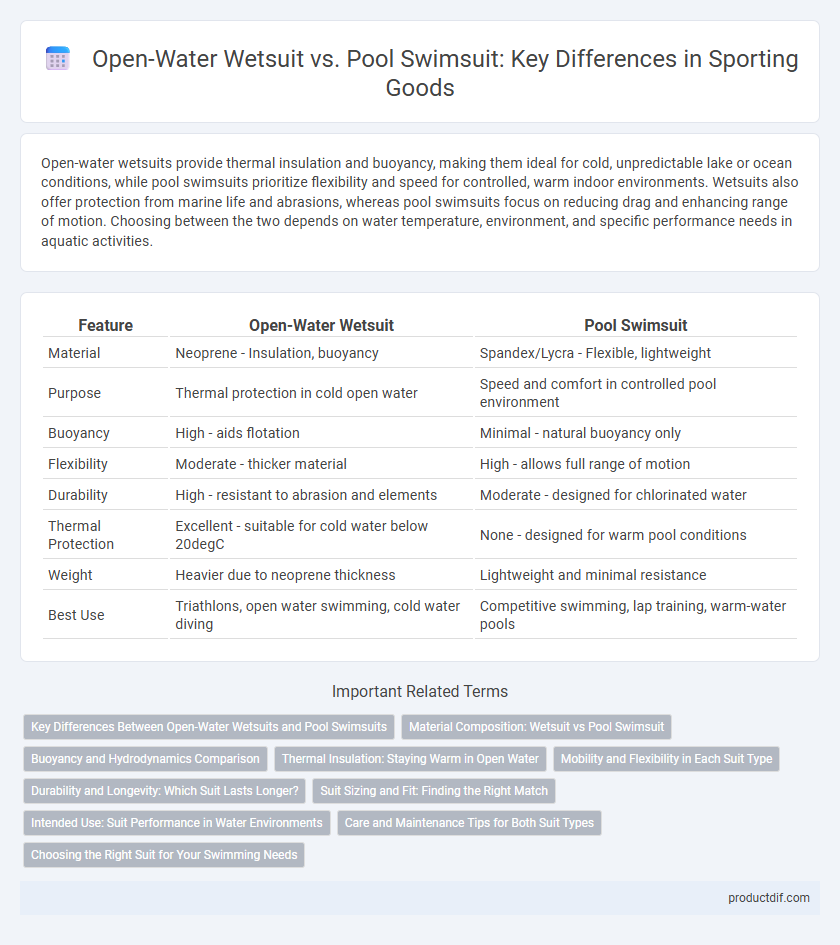Open-water wetsuits provide thermal insulation and buoyancy, making them ideal for cold, unpredictable lake or ocean conditions, while pool swimsuits prioritize flexibility and speed for controlled, warm indoor environments. Wetsuits also offer protection from marine life and abrasions, whereas pool swimsuits focus on reducing drag and enhancing range of motion. Choosing between the two depends on water temperature, environment, and specific performance needs in aquatic activities.
Table of Comparison
| Feature | Open-Water Wetsuit | Pool Swimsuit |
|---|---|---|
| Material | Neoprene - Insulation, buoyancy | Spandex/Lycra - Flexible, lightweight |
| Purpose | Thermal protection in cold open water | Speed and comfort in controlled pool environment |
| Buoyancy | High - aids flotation | Minimal - natural buoyancy only |
| Flexibility | Moderate - thicker material | High - allows full range of motion |
| Durability | High - resistant to abrasion and elements | Moderate - designed for chlorinated water |
| Thermal Protection | Excellent - suitable for cold water below 20degC | None - designed for warm pool conditions |
| Weight | Heavier due to neoprene thickness | Lightweight and minimal resistance |
| Best Use | Triathlons, open water swimming, cold water diving | Competitive swimming, lap training, warm-water pools |
Key Differences Between Open-Water Wetsuits and Pool Swimsuits
Open-water wetsuits are designed with thicker neoprene material to provide thermal insulation and buoyancy in cold, unpredictable environments, unlike pool swimsuits which prioritize minimal resistance and maximum flexibility in warm, controlled conditions. Wetsuits feature sealed seams and zippers to reduce water entry, enhancing safety and comfort during long swims in varying temperatures, whereas pool swimsuits are lightweight and streamlined for speed and mobility. The durability and coverage of open-water wetsuits also protect against marine hazards, contrasting with the exposure accepted in a pool setting where water conditions are regulated.
Material Composition: Wetsuit vs Pool Swimsuit
Open-water wetsuits are primarily made of neoprene, a synthetic rubber that provides insulation and buoyancy by trapping a thin layer of water warmed by body heat. Pool swimsuits use lightweight, chlorine-resistant fabrics like polyester or PBT blends, designed for durability and flexibility without thermal protection. The neoprene's thickness in wetsuits varies to optimize warmth in cold water, while pool swimsuits prioritize hydrodynamic performance and quick-drying features.
Buoyancy and Hydrodynamics Comparison
Open-water wetsuits provide superior buoyancy due to their neoprene construction, which traps air and helps swimmers maintain optimal body position in open water. In contrast, pool swimsuits prioritize hydrodynamics with slick, low-drag fabrics designed to reduce water resistance and enhance speed in controlled environments. The buoyancy advantage of wetsuits improves endurance and safety in open-water conditions, while pool swimsuits optimize streamline efficiency for competitive performance.
Thermal Insulation: Staying Warm in Open Water
Open-water wetsuits provide superior thermal insulation by using neoprene material that traps a thin layer of water warmed by body heat, essential for maintaining core temperature in cold environments. Pool swimsuits lack this insulating layer, making them inadequate for prolonged exposure to chilly open water. Choosing a wetsuit over a pool swimsuit significantly enhances safety and comfort during open-water swimming sessions.
Mobility and Flexibility in Each Suit Type
Open-water wetsuits offer enhanced flexibility with neoprene materials designed to retain warmth while allowing broad range of motion critical in variable conditions. Pool swimsuits prioritize mobility with streamlined, lightweight fabrics that minimize drag and maximize speed and freedom of movement. Both suit types focus on optimizing performance; wetsuits balance insulation and flexibility, while pool swimsuits emphasize unrestricted stroke efficiency.
Durability and Longevity: Which Suit Lasts Longer?
Open-water wetsuits are engineered with thicker neoprene and reinforced seams to withstand harsh marine environments, offering superior durability compared to pool swimsuits designed primarily for indoor use. The longevity of open-water wetsuits can exceed several seasons of frequent use, maintaining thermal protection and flexibility despite exposure to saltwater, UV rays, and abrasion. In contrast, pool swimsuits typically have a shorter lifespan due to chlorine degradation impacting fabric elasticity and color retention over time.
Suit Sizing and Fit: Finding the Right Match
Open-water wetsuits require a snug, compressive fit to minimize water entry and maintain insulation, with sizing often based on precise body measurements including chest, waist, and height for optimal thermal protection. Pool swimsuits prioritize flexibility and comfort, favoring streamlined fits that allow full range of motion without tight compression, typically sized by standard chest and hip measurements. Proper fit in both ensures performance efficiency, with wetsuits emphasizing thermal seal and swimsuits focusing on freedom of movement.
Intended Use: Suit Performance in Water Environments
Open-water wetsuits are engineered with thicker neoprene to provide superior thermal insulation, buoyancy, and protection against cold, currents, and marine hazards, making them ideal for extended swims in open water environments. In contrast, pool swimsuits prioritize hydrodynamic efficiency with streamlined, lightweight materials designed to reduce drag and enhance speed in controlled, warm-water conditions. Selecting the appropriate suit directly influences performance outcomes by aligning technical features with environmental demands and swim duration.
Care and Maintenance Tips for Both Suit Types
Open-water wetsuits require thorough rinsing with freshwater after each use to remove salt, sand, and bacteria, preventing material degradation and odor build-up. Pool swimsuits demand gentle washing with mild detergent to avoid chlorine damage, which can cause fading and fabric weakening over time. Storing both suit types in a cool, dry place away from direct sunlight prolongs elasticity and overall durability.
Choosing the Right Suit for Your Swimming Needs
Open-water wetsuits provide thermal insulation and buoyancy, making them ideal for cold, unpredictable conditions and longer swims in lakes, oceans, or rivers. Pool swimsuits prioritize hydrodynamics and freedom of movement, using lightweight, chlorine-resistant fabrics designed for lap swimming and competitions. Selecting the right suit depends on water temperature, swim duration, and performance requirements to optimize comfort and efficiency.
Open-water wetsuit vs Pool swimsuit Infographic

 productdif.com
productdif.com